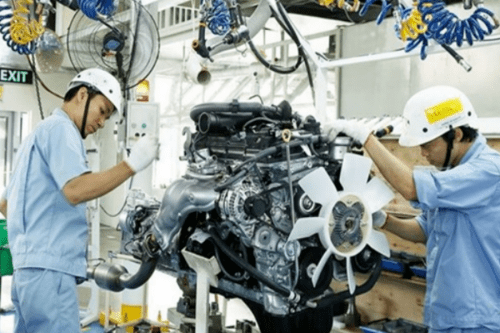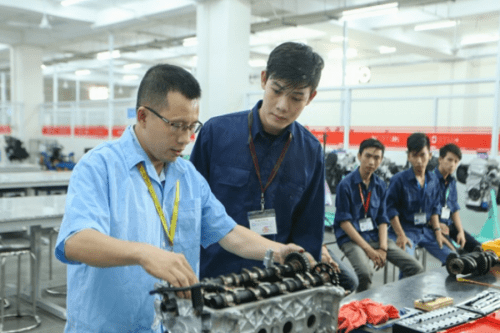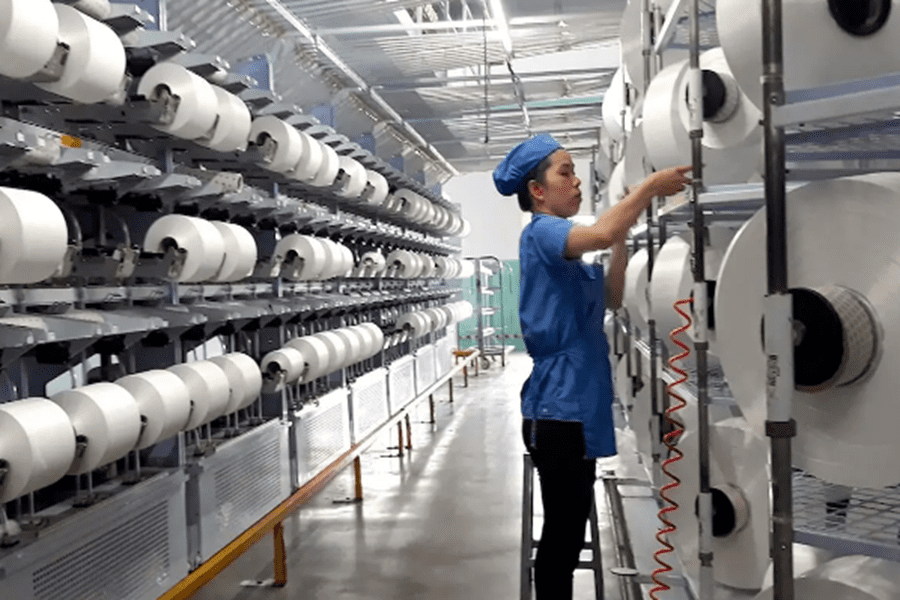Cơ khí là một trong những ngành quan trong xã hội chúng ta. Hôm nay, hãy điểm qua những từ vựng tiếng Anh chuyên ngành cơ khí mà TDP IELTS đã tổng hợp nhé!

Nội dung
ToggleTừ vựng tiếng Anh chuyên ngành cơ khí
Từ vựng tiếng Anh chuyên ngành cơ khí là một phần thiết yếu trong chuyên ngành này. Điểm qua các đề mục về từ vựng tiếng Anh chuyên ngành cơ khí sau.
Từ vựng về dụng cụ cơ khí
Các dụng cụ cơ khí là phần thiết yếu của cuộc sống. Học thêm Từ vựng tiếng Anh chuyên ngành cơ khí sau đề gia tăng khả năng giao tiếp của bạn nhé!
Tool (Dụng cụ, dao):
- Phát âm: /tuːl/
- Ví dụ: “A skilled worker knows how to choose the right tool for the job.”
Facing tool (Dao tiện mặt đầu):
- Phát âm: /ˈfeɪsɪŋ tuːl/
- Ví dụ: “The machinist used a facing tool to create a smooth surface on the metal.”
Roughing turning tool (Dao tiện thô):
- Phát âm: /ˈrʌfɪŋ ˈtɜːnɪŋ tuːl/
- Ví dụ: “The roughing turning tool quickly removes excess material from the workpiece.”
Finishing turning tool (Dao tiện tinh):
- Phát âm: /ˈfɪnɪʃɪŋ ˈtɜːnɪŋ tuːl/
- Ví dụ: “The finishing turning tool is used for precision work to achieve a smooth surface.”
Pointed turning tool (Dao tiện tinh đầu nhọn):
- Phát âm: /ˈpɔɪntɪd ˈtɜːnɪŋ tuːl/
- Ví dụ: “The pointed turning tool is ideal for creating intricate details in the workpiece.”
Board turning tool (Dao tiện tinh rộng bản):
- Phát âm: /bɔːd ˈtɜːnɪŋ tuːl/
- Ví dụ: “A board turning tool is efficient for shaping wide surfaces of the material.”
Left/right hand cutting tool (Dao tiện trái/phải):
- Phát âm: /left/raɪt hænd ˈkʌtɪŋ tuːl/
- Ví dụ: “A left-hand cutting tool is used when machining from left to right.”

Straight turning tool (Dao tiện đầu thẳng):
- Phát âm: /streɪt ˈtɜːnɪŋ tuːl/
- Ví dụ: “The straight turning tool is suitable for creating cylindrical shapes.”
Cutting –off tool, parting tool (Dao tiện cắt đứt):
- Phát âm: /ˈkʌtɪŋ –ɒf tuːl, ˈpɑːtɪŋ tuːl/
- Ví dụ: “A cutting-off tool is used to separate a part from the main workpiece.”
Thread tool (Dao tiện ren):
- Phát âm: /θred tuːl/
- Ví dụ: “The thread tool is essential for creating precise threads on a workpiece.”
Chamfer tool (Dao vát mép):
- Phát âm: /ˈʧæmfə tuːl/
- Ví dụ: “A chamfer tool is used to create beveled edges for a finished look.”
Boring tool (Dao tiện lỗ):
- Phát âm: /ˈbɔːrɪŋ tuːl/
- Ví dụ: “A boring tool is employed to enlarge or smooth out existing holes.”
Profile turning tool (Dao tiện định hình):
- Phát âm: /ˈprəʊfaɪl ˈtɜːnɪŋ tuːl/
- Ví dụ: “A profile turning tool is used to shape the workpiece according to a specific profile.”
Milling cutter (Dao phay):
- Phát âm: /ˈmɪlɪŋ ˈkʌtə/
- Ví dụ: “The milling cutter is a versatile tool used for cutting and shaping a variety of materials.”
Angle cutter (Dao phay góc):
- Phát âm: /ˈæŋgl ˈkʌtə/
- Ví dụ: “An angle cutter is designed to cut materials at specific angles.”
Cylindrical milling cutter (Dao phay mặt trụ):
- Phát âm: /sɪˈlɪndrɪkəl ˈmɪlɪŋ ˈkʌtə/
- Ví dụ: “The cylindrical milling cutter is used for machining cylindrical surfaces.”
Disk-type milling cutter (Dao phay đĩa):
- Phát âm: /dɪsk-taɪp ˈmɪlɪŋ ˈkʌtə/
- Ví dụ: “A disk-type milling cutter is suitable for cutting with a circular motion.”
Dovetail milling cutter (Dao phay rãnh đuôi én):
- Phát âm: /ˈdʌvteɪl ˈmɪlɪŋ ˈkʌtə/
- Ví dụ: “The dovetail milling cutter is used to create dovetail grooves.”
End mill (Dao phay ngón):
- Phát âm: /end mɪl/
- Ví dụ: “An end mill is a type of milling cutter used for making slots and pockets.”
Face milling cutter (Dao phay mặt đầu):
- Phát âm: /feɪs ˈmɪlɪŋ ˈkʌtə/
- Ví dụ: “A face milling cutter is ideal for milling flat surfaces on the end of a workpiece.”
Form relieved cutter (Dao phay hớt lưng):
- Phát âm: /fɔːm rɪˈliːvd ˈkʌtə/
- Ví dụ: “A form-relieved cutter is used for cutting complex shapes with precision.”
Gang milling cutter (Dao phay tổ hợp):
- Phát âm: /gæŋ ˈmɪlɪŋ ˈkʌtə/
- Ví dụ: “A gang milling cutter is capable of machining multiple surfaces simultaneously.”
Helical tooth cutter (Dao phay răng xoắn):
- Phát âm: /ˈhelɪkəl tuːθ ˈkʌtə/
- Ví dụ: “The helical tooth cutter is effective for high-speed machining and smooth cutting.”
Inserted-blade milling cutter (Dao phay răng ghép):
- Phát âm: /ɪnˈsɜːtɪd-bleɪd ˈmɪlɪŋ ˈkʌtə/
- Ví dụ: “An inserted-blade milling cutter allows for easy replacement of cutting edges.”
Key-seat milling cutter (Dao phay rãnh then):
- Phát âm: /kiː-siːt ˈmɪlɪŋ ˈkʌtə/
- Ví dụ: “A key-seat milling cutter is used for cutting keyways in a workpiece.”
Plain milling cutter (Dao phay đơn):
- Phát âm: /pleɪn ˈmɪlɪŋ ˈkʌtə/
- Ví dụ: “The plain milling cutter is a basic tool for removing material in a simple, flat pattern.”
Right-hand milling cutter (Dao phay răng xoắn phải):
- Phát âm: /raɪt-hænd ˈmɪlɪŋ ˈkʌtə/
- Ví dụ: “A right-hand milling cutter is designed for clockwise rotation during machining.”
Single-angle milling cutter (Dao phay góc đơn):
- Phát âm: /ˈsɪŋgl-ˈæŋgl ˈmɪlɪŋ ˈkʌtə/
- Ví dụ: “A single-angle milling cutter is used for creating chamfers or beveled edges.”
Slitting saw, circular saw (Dao phay cắt đứt):
- Phát âm: /ˈslɪtɪŋ sɔː, ˈsɜːkjʊlə sɔː/
- Ví dụ: “A slitting saw, also known as a circular saw, is used for cutting and slotting.”
Slot milling cutter (Dao phay rãnh):
- Phát âm: /slɒt ˈmɪlɪŋ ˈkʌtə/
- Ví dụ: “The slot milling cutter is ideal for cutting narrow slots in a workpiece.”
Shank-type cutter (Dao phay ngón):
- Phát âm: /ʃæŋk-taɪp ˈkʌtə/
- Ví dụ: “A shank-type cutter is mounted on the end of a shank and is used for specific machining tasks.”
Staggered tooth milling cutter (Dao phay răng so le):
- Phát âm: /ˈstægəd tuːθ ˈmɪlɪŋ ˈkʌtə/
- Ví dụ: “A staggered tooth milling cutter is effective for reducing vibrations during cutting.”
T-slot cutter (Dao phay rãnh chữ T):
- Phát âm: /tiː-slɒt ˈkʌtə/
- Ví dụ: “A T-slot cutter is designed to mill T-shaped slots in a workpiece.”
Three-side milling cutter (Dao phay dĩa 3 mặt cắt):
- Phát âm: /θriː-saɪd ˈmɪlɪŋ ˈkʌtə/
- Ví dụ: “A three-side milling cutter is used for milling three surfaces simultaneously.”
Two-lipped end mills (Dao phay rãnh then):
- Phát âm: /tuː-lɪpt ɛnd mɪlz/
- Ví dụ: “Two-lipped end mills are versatile tools for milling slots and contours.”
Từ vựng về máy móc cơ khí
Từ vựng tiếng Anh chuyên ngành cơ khí liên quan đến máy móc cơ khí rất quan trọng. Bỏ túi ngay các Từ vựng tiếng Anh chuyên ngành cơ khí sau nhé.
Automatic lathe (Máy tiện tự động):
- Phát âm: /ˌɔːtəˈmætɪk leɪð/
- Mô tả: Máy tiện tự động là một loại máy tiện có khả năng thực hiện các quy trình tiện tự động mà không cần sự can thiệp của người vận hành.
- Ví dụ: “The automatic lathe increased production efficiency by automating the turning process.”
Backing-off lathe (Máy tiện hớt lưng):
- Phát âm: /ˈbækɪŋ-ɒf leɪð/
- Mô tả: Máy tiện hớt lưng được sử dụng để loại bỏ một phần của bề mặt lưng trên một chi tiết gia công.
- Ví dụ: “The machinist used a backing-off lathe to create a smooth relief on the workpiece.”
Bench lathe (Máy tiện để bàn):
- Phát âm: /benʧ leɪð/
- Mô tả: Máy tiện được thiết kế để sử dụng trên bàn làm việc hoặc bàn làm việc nhỏ.
- Ví dụ: “The bench lathe is ideal for hobbyists and small-scale machining projects.”
Boring lathe (Máy tiện-doa, máy tiện đứng):
- Phát âm: /ˈbɔːrɪŋ leɪð/
- Mô tả: Máy tiện-doa hay máy tiện đứng được sử dụng để tiện lỗ hoặc mặt ngoại của một chi tiết.
- Ví dụ: “The boring lathe is perfect for creating precise holes with accurate dimensions.”
Camshaft lathe (Máy tiện trục cam):
- Phát âm: /ˈkæmʃɑːft leɪð/
- Mô tả: Máy tiện trục cam được thiết kế đặc biệt để tiện trục cam, một bộ phận quan trọng trong động cơ.
- Ví dụ: “The camshaft lathe ensures the accurate machining of camshafts for high-performance engines.”
Copying lathe (Máy tiện chép hình):
- Phát âm: /ˈkɒpiɪŋ leɪð/
- Mô tả: Máy tiện chép hình được sử dụng để sao chép chính xác hình dạng của một mẫu vào một chi tiết gia công.
- Ví dụ: “The copying lathe reproduced intricate designs on multiple workpieces.”
Cutting –off lathe (Máy tiện cắt đứt):
- Phát âm: /ˈkʌtɪŋ –ɒf leɪð/
- Mô tả: Máy tiện cắt đứt được sử dụng để tách một phần của chi tiết ra khỏi bề mặt chính.
- Ví dụ: “The cutting-off lathe is efficient for separating individual components from a larger workpiece.”
Engine lathe (Máy tiện ren vít vạn năng):
- Phát âm: /ˈenʤɪn leɪð/
- Mô tả: Máy tiện ren vít vạn năng là loại máy tiện được sử dụng rộng rãi trong công nghiệp để tiện và làm mịn chi tiết.
- Ví dụ: “The engine lathe is a versatile tool for turning, facing, and threading operations.”
Facing lathe (Máy tiện mặt đầu, máy tiện cụt):
- Phát âm: /ˈfeɪsɪŋ leɪð/
- Mô tả: Máy tiện mặt đầu, còn được gọi là máy tiện cụt, được sử dụng để tiện mặt đầu của một chi tiết.
- Ví dụ: “The facing lathe ensures a smooth and flat surface on the end of the workpiece.”
Machine lathe (Máy tiện vạn năng):
- Phát âm: /məˈʃiːn leɪð/
- Mô tả: Máy tiện vạn năng là một loại máy tiện có khả năng thực hiện nhiều loại công việc gia công khác nhau.
- Ví dụ: “The machine lathe is equipped with various attachments for versatile machining tasks.”
Multicut lathe (Máy tiện nhiều dao):
- Phát âm: /ˌmʌltɪˈkʌt leɪð/
- Mô tả: Máy tiện nhiều dao có khả năng thực hiện nhiều cắt một lúc, tăng hiệu suất gia công.
- Ví dụ: “The multicut lathe speeds up the machining process by making multiple cuts simultaneously.”
Multiple-spindle lathe (Máy tiện nhiều trục chính):
- Phát âm: /ˈmʌltɪpl-ˈspɪndl leɪð/
- Mô tả: Máy tiện nhiều trục chính có thể gia công nhiều chi tiết cùng một lúc, nâng cao hiệu suất sản xuất.
- Ví dụ: “The multiple-spindle lathe is ideal for mass production of small components.”
Precision lathe (Máy tiện chính xác):
- Phát âm: /prɪˈsɪʒən leɪð/
- Mô tả: Máy tiện chính xác được sử dụng để đạt được kích thước và bề mặt chính xác cao trên chi tiết gia công.
- Ví dụ: “The precision lathe is essential for producing components with tight tolerances.”
Profile-turning lathe (Máy tiện chép hình):
- Phát âm: /ˈprəʊfaɪl-ˈtɜːnɪŋ leɪð/
- Mô tả: Máy tiện chép hình được sử dụng để tạo hình chính xác trên bề mặt chi tiết.
- Ví dụ: “The profile-turning lathe is capable of reproducing complex profiles on workpieces.”
Relieving lathe (Máy tiện hớt lưng):
- Phát âm: /rɪˈliːvɪŋ leɪð/
- Mô tả: Máy tiện hớt lưng được sử dụng để tạo ra các khu vực hớt lưng hoặc hình dạng đặc biệt trên chi tiết.
- Ví dụ: “The relieving lathe is effective for creating relieved areas or special shapes on a workpiece.”
Screw/Thread-cutting lathe (Máy tiện ren):
- Phát âm: /skruː/θred-ˈkʌtɪŋ leɪð/
- Mô tả: Máy tiện ren được thiết kế đặc biệt để tiện ren trên bề mặt chi tiết.
- Ví dụ: “The screw/thread-cutting lathe is essential for producing accurate threads on components.”
Semi Automatic lathe (Máy tiện bán tự động):
- Phát âm: /ˈsemi ˌɔːtəˈmætɪk leɪð/
- Mô tả: Máy tiện bán tự động kết hợp giữa sự tự động và sự kiểm soát của người vận hành.
- Ví dụ: “The semi-automatic lathe offers a balance between automation and manual control for precision machining.”
Turret lathe (Máy tiện rơ-vôn-ve):
- Phát âm: /ˈtʌrɪt leɪð/
- Mô tả: Máy tiện rơ-vôn-ve có một trụ chứa nhiều dao cắt, cho phép thực hiện nhiều công đoạn gia công mà không cần sự can thiệp của người vận hành.
- Ví dụ: “The turret lathe is known for its ability to perform multiple machining operations without manual tool changes.”
Wood lathe (Máy tiện gỗ):
- Phát âm: /wʊd leɪð/
- Mô tả: Máy tiện gỗ được thiết kế đặc biệt để tiện và tạo hình các sản phẩm từ gỗ.
- Ví dụ: “The wood lathe is commonly used by woodworkers to create intricate designs and shapes in wooden pieces.”
Từ vựng về bộ phận của máy móc
Từ vựng tiếng Anh chuyên ngành cơ khí liên quan đến bộ phận của máy móc khá đơn giản. Việc học ngay các Từ vựng tiếng Anh chuyên ngành cơ khí sau cũng sẽ không quá khó khăn đâu.
Workpiece (Phôi):
- Phát âm: /ˈwɜːkˌpiːs/
- Mô tả: Phôi là một chi tiết gia công chưa hoàn thiện, được đặt vào máy công cụ để thực hiện các quy trình gia công và tạo ra sản phẩm cuối cùng.
- Ví dụ: “The machinist secured the workpiece in the lathe before starting the turning operation.”
Chip (Phoi):
- Phát âm: /ʧɪp/
- Mô tả: Chip là mảnh nhỏ của vật liệu được cắt hoặc tạo ra trong quá trình gia công bằng máy công cụ.
- Ví dụ: “The milling process produces chips as the cutting tool removes material from the workpiece.”
Chief Angles (Các góc chính):
- Phát âm: /ʧiːf ˈæŋglz/
- Mô tả: Các góc chính là các góc quan trọng được đặc tả trong thiết kế của dao cụ cắt để đảm bảo hiệu suất và chất lượng cắt.
- Ví dụ: “The chief angles of the milling cutter contribute to its efficiency in removing material.”
Rake Angle (Góc trước):
- Phát âm: /reɪk ˈæŋgl/
- Mô tả: Góc trước là góc giữa mặt cắt của dao và một đường vuông góc với mặt làm việc của phôi.
- Ví dụ: “Adjusting the rake angle can improve the cutting performance of the tool.”
Face (Mặt trước):
- Phát âm: /feɪs/
- Mô tả: Mặt trước là mặt của dao hướng về phía công việc hoặc phôi.
- Ví dụ: “The face of the cutting tool contacts the workpiece during the machining process.”
Flank (Mặt sau):
- Phát âm: /flæŋk/
- Mô tả: Mặt sau là mặt của dao nằm phía sau mặt cắt chính, không tiếp xúc trực tiếp với công việc hoặc phôi.
- Ví dụ: “The flank of the tool provides support and stability during cutting.”
Nose (Mũi dao):
- Phát âm: /nəʊz/
- Mô tả: Mũi dao là phần của dao tiếp xúc trực tiếp với công việc hoặc phôi và thực hiện quá trình cắt.
- Ví dụ: “The sharp nose of the drill bit creates a hole in the workpiece.”
Auxiliary Cutting Edge (Lưỡi cắt phụ) hoặc End Cutting (Lưỡi cắt đầu):
- Phát âm: /ɔːgˈzɪljəri ˈkʌtɪŋ eʤ = end ˈkʌtɪŋ/
- Mô tả: Lưỡi cắt phụ hoặc lưỡi cắt đầu là một phần của dao cụ cắt, có thể được sử dụng để thực hiện các quy trình gia công khác nhau.
- Ví dụ: “The end cutting edge is ideal for creating precise features on the workpiece.”
Clearance Angle (Góc sau):
- Phát âm: /ˈklɪərəns ˈæŋgl/
- Mô tả: Góc sau là góc giữa mặt sau của dao và một đường vuông góc với mặt làm việc của phôi.
- Ví dụ: “The clearance angle prevents the tool from rubbing against the workpiece, reducing friction.”
Lip Angle (Góc sắc):
- Phát âm: /lɪp ˈæŋgl/
- Mô tả: Góc sắc là góc giữa mặt cắt của dao và một đường vuông góc với mặt làm việc của phôi.
- Ví dụ: “The lip angle influences the sharpness and efficiency of the cutting tool.”
Cutting Angle (Góc cắt):
- Phát âm: /ˈkʌtɪŋ ˈæŋgl/
- Mô tả: Góc cắt là góc giữa mặt cắt của dao và một đường vuông góc với hướng chạy dao.
- Ví dụ: “The cutting angle affects the chip formation and material removal during machining.”
Auxiliary Clearance Angle (Góc sau phụ):
- Phát âm: /ɔːgˈzɪljəri ˈklɪərəns ˈæŋgl/
- Mô tả: Góc sau phụ là một góc bổ sung giữa mặt sau của dao và một đường vuông góc với mặt làm việc của phôi.
- Ví dụ: “The auxiliary clearance angle provides additional clearance for efficient cutting.”
Plane Approach Angle (Góc nghiêng chính):
- Phát âm: /pleɪn əˈprəʊʧ ˈæŋgl/
- Mô tả: Góc nghiêng chính là góc giữa mặt tiếp xúc của dao và mặt làm việc của phôi trong phương tiếp cận của dao.
- Ví dụ: “The plane approach angle influences the cutting action and surface finish.”
Auxiliary Plane Angle (Góc nghiêng phụ):
- Phát âm: /ɔːgˈzɪljəri pleɪn ˈæŋgl/
- Mô tả: Góc nghiêng phụ là góc bổ sung giữa mặt tiếp xúc của dao và mặt làm việc của phôi trong phương tiếp cận của dao.
- Ví dụ: “The auxiliary plane angle contributes to the overall performance of the cutting tool.”
Plane Point Angle (Góc mũi dao):
- Phát âm: /pleɪn pɔɪnt ˈæŋgl/
- Mô tả: Góc mũi dao là góc giữa mặt tiếp xúc của dao và đường trung tâm của dao.
- Ví dụ: “The plane point angle influences the sharpness and penetration ability of the cutting tool.”
Nose Radius (Bán kính mũi dao):
- Phát âm: /nəʊz ˈreɪdiəs/
- Mô tả: Bán kính mũi dao là kích thước của mũi dao, ảnh hưởng đến độ nhọn và chi tiết của mặt gia công.
- Ví dụ: “A smaller nose radius is suitable for creating fine details on the machined surface.”
Built-up Edge (Lẹo dao) hoặc BUE:
- Phát âm: /bɪlt ʌp eʤ/
- Mô tả: Lẹo dao là hiện tượng khi mảnh vật liệu bám vào mặt cắt của dao cụ, ảnh hưởng đến chất lượng cắt.
- Ví dụ: “Preventing built-up edge is crucial for maintaining the effectiveness of the cutting tool.”
Tool Life (Tuổi thọ của dao):
- Phát âm: /tuːl laɪf/
- Mô tả: Tuổi thọ của dao là thời gian hoặc số lượng phôi mà một dao cụ có thể hoạt động trước khi cần được thay thế hoặc mài lại.
- Ví dụ: “Optimizing cutting parameters can extend the tool life.”
Feed Rate (Lượng chạy dao):
- Phát âm: /fiːd reɪt/
- Mô tả: Lượng chạy dao là tốc độ di chuyển của dao cụ đối với công việc hoặc phôi, ảnh hưởng đến quá trình cắt.
- Ví dụ: “Adjusting the feed rate can control the material removal rate during machining.”
Thuật ngữ tiếng Anh về chuyên ngành cơ khí
Các nguyên lý trong chuyên ngành cơ khí
Từ vựng tiếng Anh chuyên ngành cơ khí về các nguyên lý sẽ khá khó nhằn cho người học. Cố gắng học qua Từ vựng tiếng Anh chuyên ngành cơ khí sau nhé.
Cutting theory (Nguyên lý cắt):
- Phát âm: /ˈkʌtɪŋ ˈθɪəri/
- Ví dụ: “Engineers use cutting theory to optimize machining processes and improve tool life.”
Design Automation (Tự động hóa thiết kế):
- Phát âm: /dɪˈzaɪn ˌɔːtəˈmeɪʃ(ə)n/
- Ví dụ: “The company implemented design automation to streamline the product development workflow.”
Electrical installations (Trang thiết bị điện):
- Phát âm: /ɪˈlektrɪkəl ˌɪnstəˈleɪʃənz/
- Ví dụ: “The electrical installations in the new building adhere to the latest safety standards.”
Front view (Hình chiếu đứng):
- Phát âm: /frʌnt vjuː/
- Ví dụ: “In the front view of the blueprint, the dimensions of the structure are clearly indicated.”
Labour safety (An toàn lao động):
- Phát âm: /ˈleɪbə ˈseɪfti/
- Ví dụ: “Strict adherence to labour safety protocols is essential in industrial workplaces.”
Manufacturing automation (Tự động hóa sản xuất):
- Phát âm: /ˌmænjʊˈfækʧərɪŋ ˌɔːtəˈmeɪʃ(ə)n/
- Ví dụ: “The introduction of manufacturing automation increased production efficiency.”
Oblique projection (Phép chiếu xiên):
- Phát âm: /əˈbliːk prəˈʤekʃən/
- Ví dụ: “In engineering drawings, an oblique projection provides a 3D representation with a skew angle.”
Parallel projection (Phép chiếu song song):
- Phát âm: /ˈpærəlel prəˈʤekʃən/
- Ví dụ: “Architectural plans often use parallel projection for simplicity and ease of measurement.”
Perspective projection (Phép chiếu phối cảnh):
- Phát âm: /pəˈspɛktɪv prəˈʤekʃən/
- Ví dụ: “Artists use perspective projection to create realistic depth in paintings.”
Projection plane (Mặt phẳng chiếu):
- Phát âm: /prəˈʤekʃən pleɪn/
- Ví dụ: “In technical drawings, the projection plane is crucial for accurate representation.”
Side view (Hình chiếu cạnh):
- Phát âm: /saɪd vjuː/
- Ví dụ: “The side view of the machine blueprint shows the internal components and their arrangement.”
Top view (Hình chiếu bằng):
- Phát âm: /tɒp vjuː/
- Ví dụ: “The top view provides a plan of the layout, indicating the positions of various elements.”
Thuật ngữ về lắp ráp trong chuyên ngành cơ khí
Các phương pháp lắp ráp tại chuyên ngành này và cả Từ vựng tiếng Anh chuyên ngành cơ khí về cách lắp ráp cũng là thử thách lớn đối với người học.

Adapter plate unit (Bộ gắn đầu tiêu chuẩn): /əˈdæptə pleɪt ˈjuːnɪt/
- Ví dụ: “The CNC machine includes an adapter plate unit for attaching standard tool heads.”
Abrasive belt (Băng tải gắn bột mài): /əˈbreɪsɪv belt/
- Ví dụ: “An abrasive belt is commonly used in grinding machines for precision finishing.”
Amplifier (Bộ khuếch đại): /ˈæmplɪfaɪə/
- Ví dụ: “The sensor output is connected to an amplifier to enhance the signal for accurate measurement.”
Feed selector (Bộ điều chỉnh lượng ăn dao): /fiːd sɪˈlɛktə/
- Ví dụ: “The feed selector allows the operator to adjust the cutting speed for different materials.”
Aerodynamic controller (Bộ kiểm soát khí động lực): /ˌeərəʊdaɪˈnæmɪk kənˈtrəʊlə/
- Ví dụ: “The aerodynamic controller adjusts the airflow to optimize machining conditions.”
Inductance-type pick-up (Bộ phát kiểu cảm kháng): /ɪnˈdʌktəns-taɪp pɪk-ʌp/
- Ví dụ: “An inductance-type pick-up is used to detect changes in magnetic fields for position sensing.”
Audio oscillator (Bộ dao động âm thanh): /ˈɔːdɪˌəʊ ˈɒsɪleɪtə/
- Ví dụ: “The audio oscillator generates sound waves for testing and calibration purposes.”
Adjustable support (Gối tựa điều chỉnh): /əˈʤʌstəbl səˈpɔːt/
- Ví dụ: “An adjustable support provides flexibility in positioning and securing workpieces.”
Apron (Tấm chắn): /ˈeɪprən/
- Ví dụ: “The apron on the lathe protects the operator from chips and debris during machining.”
Aileron (Cánh phụ cân bằng): /ˈeɪlərɒn/
- Ví dụ: “The ailerons on the aircraft wings help control roll and lateral stability.”
Bed shaper (Băng may): /bed ˈʃeɪpə/
- Ví dụ: “The bed shaper is a tool used in agriculture to create raised beds for planting.”
Arbor support (Ổ đỡ trục): /ˈɑːbə səˈpɔːt/
- Ví dụ: “The arbor support provides stability and alignment for the milling cutter.”
Drill chuck (Đầu kẹp mũi khoan): /drɪl ʧʌk/
- Ví dụ: “The drill chuck securely holds the drill bit in place during drilling operations.”
Camshaft (Trục cam): /ˈkæmʃɑːft/
- Ví dụ: “The camshaft controls the timing of valve opening and closing in an internal combustion engine.”
Electric-contact gauge head (Đầu đo điện tiếp xúc): /ɪˈlɛktrɪk- ˈkɒntækt geɪʤ hɛd/
- Ví dụ: “The electric-contact gauge head ensures accurate measurements with direct contact on surfaces.”
Driving pin (Chốt xoay): / ˈdraɪvɪŋ pɪn/
- Ví dụ: “The driving pin engages with the gears to transmit rotational motion.”
End mill (Dao phay mặt đầu): /end mɪl/
- Ví dụ: “An end mill is used for milling flat surfaces and creating contours in machining processes.”
Elevator (Cánh nâng): /ˈelɪveɪtə/
- Ví dụ: “The elevator on a milling machine adjusts the position of the worktable.”
Expansion reamer (Dao chuốt nong rộng): /ɪksˈpænʃən ˈriːmə/
- Ví dụ: “An expansion reamer is used to enlarge and finish precision holes in metalwork.”
End support (Giá đỡ phía sau): /end səˈpɔːt/
- Ví dụ: “The end support provides additional stability to the workpiece during machining.”
Feed shaft (Trục chạy dao): /fiːd ʃɑːft/
- Ví dụ: “The feed shaft transmits rotational motion to the cutting tool for material removal.”
Facing tool (Dao tiện mặt đầu): /ˈfeɪsɪŋ tuːl/
- Ví dụ: “A facing tool is used to create a smooth surface on the end of a workpiece.”
Fixed support (Gối tựa cố định): /fɪkst səˈpɔːt/
- Ví dụ: “A fixed support provides a rigid base for the lathe carriage during machining operations.”
Form tool (Dao định hình): /fɔːm tuːl/
- Ví dụ: “A form tool is designed for shaping workpieces with specific contours and profiles.”
Thuật ngữ về bảo trì trong chuyên ngành cơ khí

Từ vựng tiếng Anh chuyên ngành cơ khí liên quan để việc bảo trì sẽ giúp người học giao tiếp ổn hơn đấy. Học ngay từ vựng tiếng Anh chuyên ngành cơ khí ô tô sau nhé!
Preventive maintenance (Bảo trì phòng ngừa): /prɪˈvɛntɪv ˈmeɪntənəns/
- Ví dụ: “The company conducts preventive maintenance on machinery to avoid unexpected breakdowns.”
Breakdown maintenance/ Operation to Break Down (OTBD) (Bảo trì khi có hư hỏng): /ˈbreɪkˌdaʊn ˈmeɪntənəns/ ˌɒpəˈreɪʃən tuː breɪk daʊn (əʊ-tiː-biː-diː)/
- Ví dụ: “In case of a breakdown, operation to break down maintenance is initiated for immediate repairs.”
Predictive maintenance (Bảo trì dự đoán): /prɪˈdɪktɪv ˈmeɪntənəns/
- Ví dụ: “By utilizing sensors and data analysis, predictive maintenance can forecast equipment failures.”
Periodic maintenance/Time-based maintenance (TBM) / Fixed Time Maintenance (FTM) (Bảo trì định kỳ): /ˌpɜːraɪˈɒdɪk ˈmeɪntənəns /taɪm beɪst ˈmeɪntənəns (tiː-biː-em) / fɪkst taɪm ˈmeɪntənəns ( ef-tiː-em)/
- Ví dụ: “The machines undergo periodic maintenance every six months to ensure optimal performance.”
Lean Maintenance (Bảo trì tinh gọn): /liːn ˈmeɪntənəns/
- Ví dụ: “Lean maintenance focuses on eliminating waste and maximizing efficiency in maintenance processes.”
Corrective maintenance (Bảo trì khắc phục hay bảo trì hiệu chỉnh): /kəˈrektɪv ˈmeɪntənəns/
- Ví dụ: “Corrective maintenance is carried out in response to identified issues or malfunctions.”
Condition-Based Maintenance (CBM) (Bảo trì dựa trên tình trạng thiết bị): /kənˈdɪʃən beɪst ˈmeɪntənəns (siː-biː-em)/
- Ví dụ: “Condition-based maintenance uses real-time monitoring to schedule maintenance tasks based on equipment condition.”
Design Out Maintenance (DOM) (Bảo trì thiết kế lại): /dɪˈzaɪn aʊt ˈmeɪntənəns/
- Ví dụ: “Design out maintenance involves modifying equipment design to reduce maintenance needs.”
Proactive Maintenance (Bảo trì tiên phong): /prəʊˈæktɪv ˈmeɪntənəns/
- Ví dụ: “Proactive maintenance includes regular inspections and preemptive repairs to prevent failures.”
Lifetime Extension (LTE) (Bảo trì kéo dài tuổi thọ): /ˈlaɪftaɪm ɪksˈtenʃən (el-tiː-iː)/
- Ví dụ: “Lifetime extension maintenance strategies aim to extend the operational lifespan of equipment.”
Reliability Center Maintenance (RCM) (Bảo trì tập trung vào độ tin cậy): /rɪˌlaɪəˈbɪlɪti ˈsentə ˈmeɪntənəns (ɑː-siː-em)/
- Ví dụ: “Reliability-centered maintenance prioritizes maintenance efforts based on the criticality of components.”
Total Productive Maintenance (TPM) (Bảo trì năng suất toàn bộ): /ˈtəʊtl prəˈdʌktɪv ˈmeɪntənəns (tiː-piː-em)/
- Ví dụ: “Total productive maintenance aims to maximize equipment effectiveness and minimize downtime.”
Risk Based Maintenance (RBM) (Bảo trì dựa trên rủi ro): /rɪsk beɪst ˈmeɪntənəns (ɑː-biː-em)/
- Ví dụ: “Risk-based maintenance assesses potential risks to prioritize maintenance activities.”
Plant Shutdown & Turnaround Planning (Lập kế hoạch ngừng máy cho bảo trì toàn nhà máy): /plɑːnt ˈʃʌtdaʊn & ˈtɜːnəˌraʊnd ˈplænɪŋ/
- Ví dụ: “Plant shutdown and turnaround planning involve scheduling maintenance activities during planned shutdowns.”
Operator Maintenance (Bảo trì có sự tham gia nhân viên vận hành): /ˈɒpəreɪtə ˈmeɪntənəns/
- Ví dụ: “Operator maintenance empowers operators to perform routine checks and minor repairs on equipment.”
Thuật ngữ về cơ khí thủy lực trong chuyên ngành cơ khí
Cùng nhau học tập từ vựng tiếng Anh chuyên ngành cơ khí thông dụng liên quan đến thủy lực nhé!
Bore size (Đường kính trong xi lanh): /bɔː saɪz/
- Ví dụ: “The bore size of the hydraulic cylinder determines its capacity to generate force.”
Ordering code (Mã đặt hàng): /ˈɔːdərɪŋ kəʊd/
- Ví dụ: “Please provide the correct ordering code when placing your purchase order.”
Mounting code (Mã lắp ghép): /ˈmaʊntɪŋ kəʊd/
- Ví dụ: “The mounting code indicates the specific configuration for installing the components.”
Cylinder seal kit (Gioăng, phớt xi lanh): /ˈsɪlɪndə siːl kɪt/
- Ví dụ: “Regular replacement of the cylinder seal kit is essential for preventing leaks.”
Rod End Clevis (Kiểu lắp đầu xilanh hình chữ U – RC): /rɒd end ˈklevɪs/
- Ví dụ: “The Rod End Clevis provides a secure connection between the hydraulic cylinder and the load.”
Rod End Tang (Kiểu lắp đầu xilanh khớp trụ – RT): /rɒd end tæŋ/
- Ví dụ: “Rod End Tang configurations are commonly used for connecting cylinders to mechanical linkages.”
Stroke up to any practical length (Hành trình làm việc theo yêu cầu): /strəʊk ʌp tuː ˈeni ˈpræktɪkəl leŋθ/
- Ví dụ: “Our hydraulic cylinders can be customized with a stroke up to any practical length.”
Cap End Tang (Kiểu lắp đuôi xylanh khớp trụ – ET): /ˈkæp end tæŋ/
- Ví dụ: “Cap End Tang connections are suitable for applications where a pivot connection is needed.”
Double acting/Single acting (Xi lanh cần đôi/Xi lanh cần đơn): /ˈdʌbl ˈæktɪŋ/ˈsɪŋgl ˈæktɪŋ/
- Ví dụ: “Double-acting cylinders operate in both directions, while single-acting cylinders operate in one direction.”
Rod End Flange (Kiểu lắp đầu xilanh bích hình vuông – RF): /rɒd end flænʤ/
- Ví dụ: “Rod End Flange configurations provide a square flange for secure mounting.”
Rod End Spherical Bearing (Kiểu lắp đầu xilanh khớp cầu – RB): /rɒd end ˈsferɪkəl ˈbeərɪŋ/
- Ví dụ: “Rod End Spherical Bearings allow for angular misalignment in hydraulic cylinder connections.”
Cross Tube (Kiểu lắp dạng ống trụ tròn – CT): /krɒs tjuːb/
- Ví dụ: “Cross Tube connections are commonly used in hydraulic cylinders for robust performance.”
Directional control valve (Van phân phối): /dɪˈrekʃənl kənˈtrəʊl vælv/
- Ví dụ: “The directional control valve regulates the flow of hydraulic fluid to control the movement of actuators.”
Counterbalance valve (Van đối trọng): /ˈkaʊntəˌbæləns vælv/
- Ví dụ: “A counterbalance valve is used to control the motion of a load, preventing it from free-falling.”
Logic valve (Van logic): /ˈlɒʤɪk vælv/
- Ví dụ: “Logic valves are employed in hydraulic systems to control specific sequences of operations.”
Mounting Style (Mã lắp ghép đuôi xi lanh): /ˈmaʊntɪŋ staɪl/
- Ví dụ: “Selecting the appropriate mounting style ensures proper integration of hydraulic components.
Mẫu câu giao tiếp tiếng Anh sử dụng trong ngành kỹ thuật cơ khí

Dưới đây là 5 câu giao tiếp tiếng Anh sử dụng từ vựng tiếng Anh chuyên ngành cơ khí, học ngay và lựa ra những từ vựng thường dùng chuyên ngành cơ khí tiếng Anh bạn nha:
- Machine Operation (Vận hành máy):
- English: “During the machine operation, it’s crucial to monitor the spindle speed to avoid excessive heat generation.”
- Vietnamese: “Trong quá trình vận hành máy, việc theo dõi tốc độ trục chính là quan trọng để tránh tạo nhiệt độ quá mức.”
- Quality Control (Kiểm soát chất lượng):
- English: “We employ non-destructive testing methods to ensure the integrity of welded joints in our quality control process.”
- Vietnamese: “Chúng tôi sử dụng phương pháp kiểm tra không phá hủy để đảm bảo tính toàn vẹn của các đường hàn trong quy trình kiểm soát chất lượng.”
- Material Handling (Xử lý vật liệu):
- English: “Proper material handling practices, such as using cranes and forklifts, contribute to a safer work environment.”
- Vietnamese: “Các phương pháp xử lý vật liệu đúng đắn, như sử dụng cẩu và xe nâng, đóng góp vào môi trường làm việc an toàn.”
- Maintenance and Repair (Bảo dưỡng và Sửa chữa):
- English: “Scheduled maintenance is essential to prevent unexpected breakdowns and extend the lifespan of our machinery.”
- Vietnamese: “Bảo dưỡng định kỳ là quan trọng để ngăn chặn sự cố đột ngột và kéo dài tuổi thọ của máy móc chúng ta.”
Lời kết
Trên đây là những từ vựng tiếng Anh chuyên ngành cơ khí mà FB TDP IELTS đã tổng hợp dành cho bạn. Hi vọng những từ vựng tiếng Anh chuyên ngành kỹ thuật cơ khí này đã giúp bạn trên con đường chinh phục tiếng Anh tốt hơn nhé!










